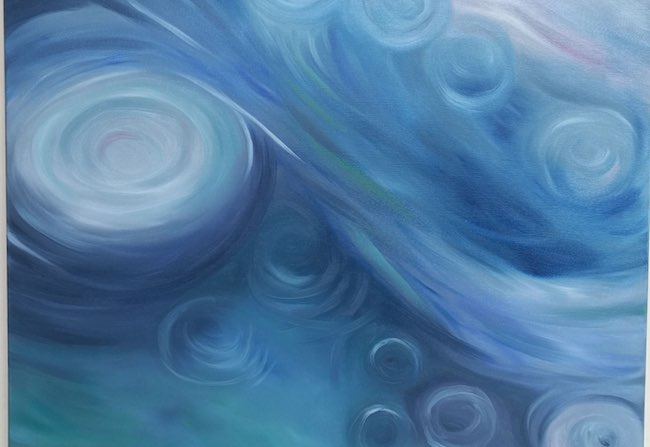L’osservazione dell’alternanza dell’esistenza, di tutte quelle modificazioni e trasformazioni che inducono l’individuo a riflettere su se stesso, a volte sentendosi trascinato dagli eventi, altre invece protagonista, è stato oggetto di studio di tutta quella categoria di creativi che non riuscivano a rimanere dentro i confini della figurazione, ad autolimitare il loro campo di riflessione solo perché lo sguardo non era capace di andare oltre e abbandonare il conosciuto per spingersi verso diversi livelli di profondità. Il distacco dall’immagine permette all’artista di mettersi in contatto diretto con il mondo interiore, quello attraverso cui lasciarsi andare al movimento della vita pur essendone attore principale. La protagonista di oggi si spinge verso la rinuncia alla forma arricchendo la sua ricerca di tecniche del passato che possono essere riattualizzate e adattate al suo stile pittorico.
Il percorso di riappropriazione del mondo emotivo escluso dalle avanguardie del Ventesimo secolo per cui tutto ciò che doveva essere centrale era la razionalità, la scientificità, lo studio della geometria, della non forma, della prevalenza della purezza del gesto plastico su tutta la realtà osservata, ebbe inizio intorno alla metà degli anni Quaranta del Novecento, quando un gruppo di creativi statunitensi, molti dei quali con origini europee ma costretti a fuggire dalla loro madrepatria nel periodo bellico, reclamarono con forza la necessità dell’arte di legarsi al mondo emozionale, di affondare le radici nella sfera soggettiva dell’esecutore dell’opera per poter raggiungere e a volte travolgere l’osservatore. L’assenza di forma conosciuta, di una struttura visiva che avrebbe indotto a soffermarsi sull’estetica, sull’approccio visivo piuttosto che su quello intuitivo, era essenziale per donare libertà espressiva, assecondata al carattere e alla naturale inclinazione di ciascun componente del gruppo, così come per riallacciarsi a quelle anticipatrici intuizioni del padre dell’Astrattismo, Vassily Kandinsky, che poi vennero sovvertite e superate dai movimenti successivi. Nell’Espressionismo Astratto invece la realtà era quella del sentire, solo le emozioni e l’impulso pittorico costituivano la base esecutiva, senza regole, senza schemi da osservare se non quello dell’autonomia espressiva; dunque l’istinto quasi irruento di Jackson Pollock poteva convivere con la silenziosa meditazione di Mark Rothko, così come il monocromo minimalista di Ad Reinhardt poteva affiancarsi alla leggera delicatezza di CY Twombly perché la legge che regolava gli appartenenti al gruppo era quella della spontaneità, della naturalezza proveniente dall’interiorità per poi raggiungere la tela. Quella corrente pittorica costituì l’anticipazione, nonché l’evoluzione naturale del percorso dell’arte, di ciò che sarebbero diventati gli anni seguenti, aperti all’interazione, all’apertura e alla libertà che sfociò nella contaminazione e nella mescolanza tra stili differenti, spesso evoluzione di tutto ciò che c’era stato prima. Non solo, il linguaggio diretto e senza filtri da parte della mente razionale aveva, e ha ancora oggi, la capacità di parlare in modo intenso all’osservatore, coinvolgendolo attraverso le corde interiori che non possono fare a meno di vibrare davanti al mondo al femminile di Helen Frankenthaler, o dei segni essenziali di Franz Kline oppure delle atmosfere suggestive di Barnett Newman. L’artista emiliana Carlotta Mantovani assorbe l’esperienza di autonomia espressiva delineata dall’Espressionismo Astratto ma la rivisita sulla base della sua esigenza interiore, intesa come percorso necessario a prendere coscienza, a entrare in contatto con quel mondo sotterraneo che solo in virtù dell’arte può riuscire a emergere e a far sentire la sua voce.
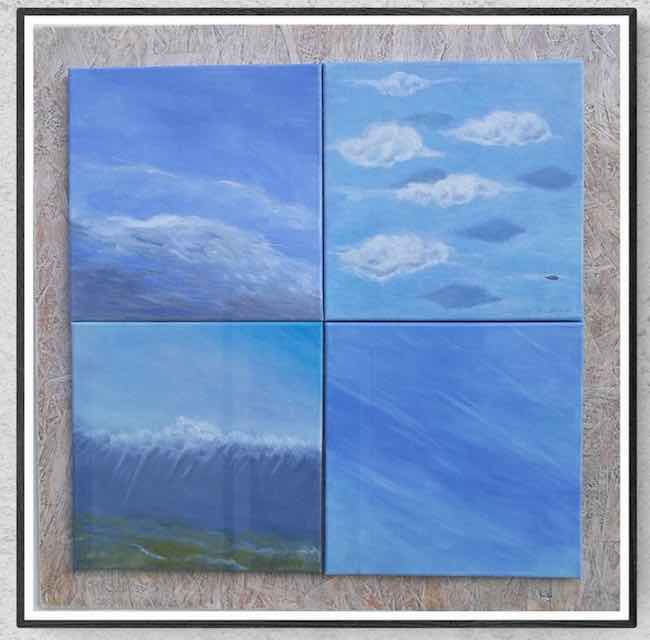
Non solo, ogni opera rappresenta un mondo a sé, un costante studio della tecnica più affine al momento che sente la necessità di immortalare, meditando su quale sia lo stile in grado di concretizzare al meglio il suo sentire; la gamma cromatica di conseguenza non può non essere funzionale all’emozione narrata, assumendo tonalità e caratteristiche sfaccettate e diverse tanto quanto poliedriche e mobili sono le sensazioni della Mantovani nel momento in cui comincia il suo dialogo con la tela.
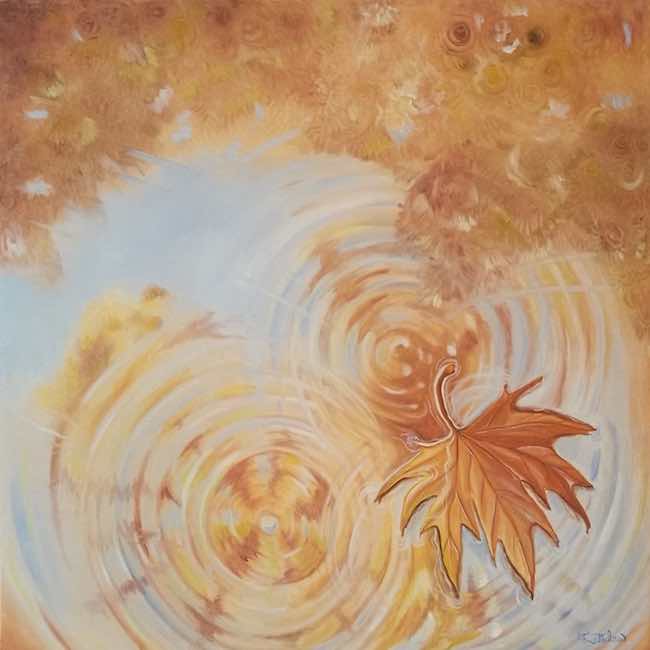
Quando desidera abbandonarsi a quella mobilità, quel costante fluire eracliteo che spinge verso la consapevolezza della perpetua evoluzione, del continuo movimento della realtà in correlazione non solo al punto di vista dell’individuo ma anche della fase della sua vita e dell’esperienza fino a quel frangente acquisita, allora le tonalità sono chiare, acquatiche proprio perché l’acqua è l’elemento che più di tutti rappresenta lo scorrere di ogni istante, irripetibile e pertanto diverso dal precedente e dal successivo.
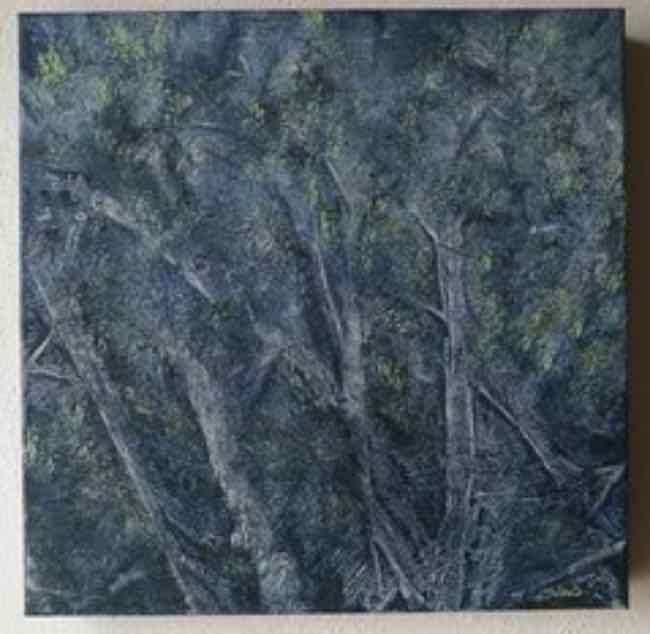
Quando invece ha bisogno di affrontare, capire ed esorcizzare fantasmi, timori, paure che inevitabilmente investono la coscienza e l’interiorità in alcune circostanze imprevedibili e non decise, le atmosfere si fanno più ombrose, più cupe perché a volte è necessario immergersi nel buio e nel silenzio per apprezzare o intravedere con maggiore lucidità il ritorno della luce; in questa serie di opere è evidente l’approccio differente di Carlotta Mantovani, quel soffermarsi sull’oscurità il tempo necessario a prendere coscienza degli accadimenti, frazionarne le sensazioni da essi provocate e riemergere a una nuova e inedita coscienza di un sé più evoluto, più saggio esattamente grazie all’ostacolo, alla possibilità di attraversare il buio per trovare il modo di uscirne.
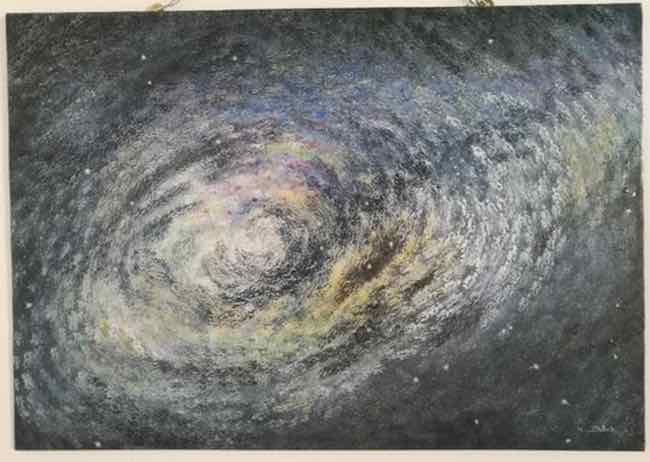
L’opera Oltre confine nel profondo si lega a una fase delicata del cammino dell’artista ma anche dell’intera umanità, quella della pandemia, durante la quale tutto sembrava essere immobile, senza via d’uscita, con il timore che quell’episodio divenisse una nuova normalità; la Mantovani sembra invitare l’osservatore a riflettere, a meditare e a trovare dentro se stesso la linfa per credere che tutto può prendere una strada diversa se solo si è capaci di attingere alla forza e alla determinazione che è dentro ciascuno. Lo stile espressionista astratto si unisce a una tecnica simile al Puntinismo laddove però in questo caso i puntini di colore non vanno a costituire l’immagine finale bensì semplicemente approfondiscono ed enfatizzano quell’invito a entrare nel vortice delle proprie emozioni e convivere con esse. Nel suo buio non c’è mai la totale oscurità, ciò che sembra predominare, malgrado tutto, è la luminosità del sentire, delle emozioni umane che restano la sola e unica guida in un mondo estraneo che sembra seguire logiche completamente diverse, persino opposte, a quelle della felicità e della serenità del singolo.
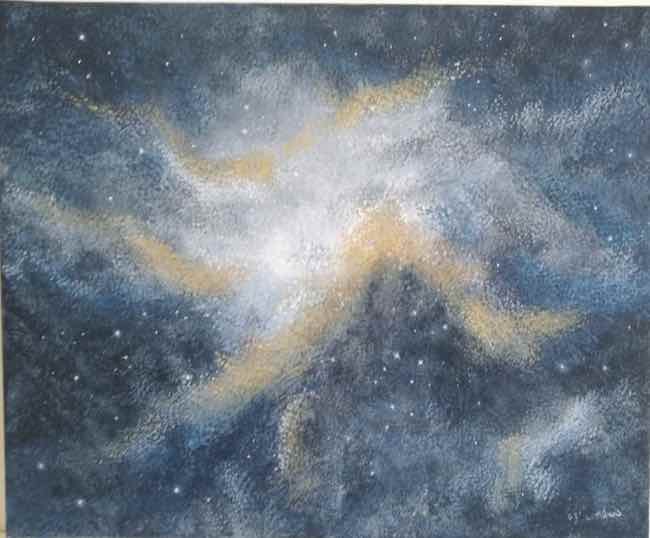
Infatti il dipinto La forma del buio, anch’essa realizzata con la tecnica del Puntinismo applicato all’Astrattismo, descrive il buio come una forma di luce, come se tutta la vita che passa e che è passata nell’arco dell’esistenza avesse lasciato una scia lucente e intensa, la certezza di rinascere e rialzarsi da qualsiasi notte.
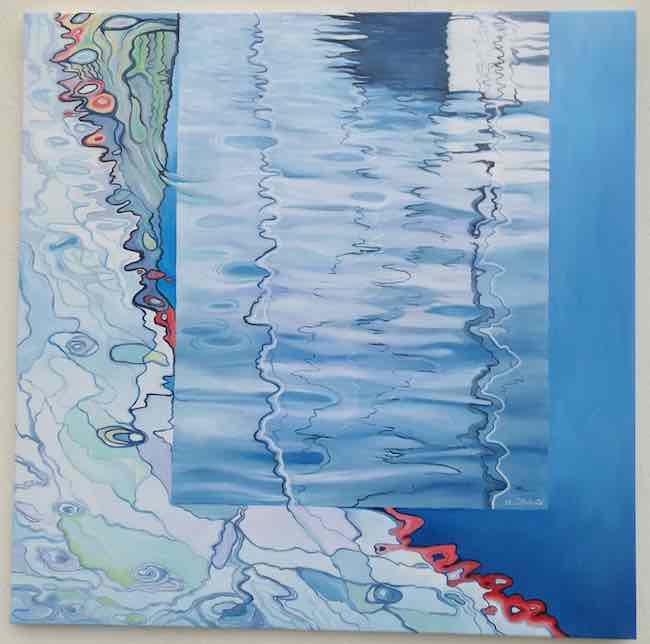
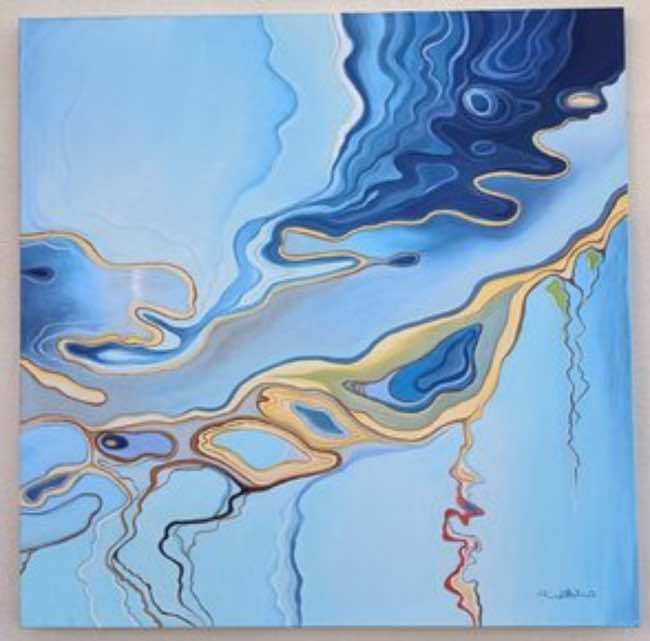
Nelle opere più acquatiche invece la scelta dei colori si inverte completamente, la luce predomina e diviene protagonista attraverso il riflesso sull’acqua, metafora di uno scorrere che corrisponde a quello del tempo, delle esperienze, delle consapevolezze, di quella crescita personale verso cui l’essere umano inevitabilmente tende pur essendone a volte inconsapevole; Carlotta Mantovani invita invece, attraverso tele come Acquaticamente o Grembo liquido, a consegnarsi a quell’ineluttabile galleggiamento in grado di condurre l’individuo nel posto migliore, quello in cui deve giungere per ampliare la sua conoscenza, la sua autoconsapevolezza, il suo evolversi e arricchire un’interiorità che ha costante bisogno di sperimentare, di mettersi alla prova, di alzare l’asticella del proprio limite. Le opere di questa seconda serie giocano sulle tonalità morbide del celeste e dell’azzurro, alcune più legate all’aria e al cielo, a loro volta elementi di movimento, di volatilità, altre invece più propriamente fluide, acquatiche appunto. Le prospettive sono decontestualizzate, scomposte o collocate all’interno di una finestra spazio-temporale, proprio per infondere nell’osservatore il desiderio di immergersi anche per un solo istante dentro quel silenzio fluttuante in cui ritrovare la protezione primordiale, quella del grembo materno, per poi riaffiorare con una sicurezza in se stesso rinnovato, certo che proprio attraverso la capacità di ascoltare le energie che corrono su un filo diverso dalla razionalità, tutto possa essere possibile. Carlotta Mantovani, diplomata all’Accademia di Belle Arti di Bologna e con un passato come illustratrice, ha attualmente all’attivo la partecipazione a molte mostre collettive in Italia, ha ricevuto il Premio La Nike di Samotracia, conferito dalla l’Associazione Galleria Centro Storico di Firenze, il Premio Mercurio d’Oro, conferito da ArtExpò Gallery e il Premio internazionale arte contemporanea Isabella d’Este conferito da ArtNow.
CARLOTTA MANTOVANI-CONTATTI
Email: carlottamantovani61@gmail.com
Sito web: https://carlottamanu.art/
Facebook: https://www.facebook.com/carlotta.mantovani
Instagram: https://www.instagram.com/mantovani.carlotta/
The flow of existence between light and shadow in Carlotta Mantovani’s pictorial experimentations
The observation of the alternation of existence, of all those modifications and transformations that induce the individual to reflect on himself, sometimes feeling dragged by events, at other times the protagonist, has been the object of study of that entire category of creative artists who were unable to remain within the confines of figuration, to self-limit their field of reflection simply because their gaze was unable to go beyond and abandon the known to push towards different levels of depth. Detachment from the image allows the artist to make direct contact with the inner world, the one through which to let go on the movement of life while still being its main actor. Today’s protagonist pushes towards the renunciation of form by enriching her research with techniques from the past that can be reinterpreted and adapted to her painting style.
The path of re-appropriation of the emotional world excluded by the 20th century avant-gardes for whom all that had to be central was rationality, scientificity, the study of geometry, of non-form, of the prevalence of the purity of the plastic gesture over all observed reality, began around the mid-1940s, when a group of American creatives, many of them of European origin but forced to flee their homeland during the war, forcefully reclaimed the need for art to bind itself to the emotional world, to take root in the subjective sphere of the artwork’s executor in order to reach and sometimes overwhelm the observer. The absence of a known form, of a visual structure that would induce one to dwell on aesthetics, on the visual approach rather than the intuitive one, was essential to give expressive freedom, seconded to the character and natural inclination of each member of the group, as well as to link up with those anticipatory intuitions of the father of Abstractionism, Vassily Kandinsky, which were then subverted and surpassed by later movements. In Abstract Expressionism, on the other hand, reality was that of feeling, only the emotions and the pictorial impulse constituted the executive basis, without rules, without schemes to observe except that of expressive autonomy; thus the almost impetuous instinct of Jackson Pollock could coexist with the silent meditation of Mark Rothko, just as the minimalist monochrome of Ad Reinhardt could go side by side with the light delicacy of CY Twombly because the law that governed the members of the group was that of spontaneity, of naturalness coming from the interiority to then reach the canvas. That pictorial current constituted the anticipation, as well as the natural evolution of the path of art, of what would become the following years, open to interaction, openness and freedom that resulted in the contamination and mixing of different styles, often an evolution of everything that had gone before. Not only that, the direct and unfiltered language of the rational mind had, and still has today, the ability to speak intensely to the observer, involving him through the inner chords that cannot help but vibrate in front of Helen Frankenthaler’s feminine world, or Franz Kline’s essential signs, or Barnett Newman’s suggestive atmospheres. The Emilian artist Carlotta Mantovani absorbs the experience of expressive autonomy outlined by Abstract Expressionism, but revisits it on the basis of her inner need, intended as a path necessary to gain awareness, to come into contact with that underground world that only by virtue of art can manage to emerge and make its voice heard. Not only that, but each painting represents a world of its own, a constant study of the technique most akin to the moment she feels the need to immortalise, meditating on which style can best concretise her feelings; the chromatic range consequently cannot but be functional to the emotion narrated, taking on multifaceted and diverse tonalities and characteristics, just as multifaceted and mobile are Mantovani’s sensations at the moment she begins her dialogue with the canvas.
When she wishes to abandon herself to that mobility, that constant Heraclitean flow that pushes towards the awareness of perpetual evolution, of the continuous movement of reality in correlation not only with the individual’s point of view but also with the phase of his life and the experience acquired up to that juncture, then the tones are clear, aquatic precisely because water is the element that most of all represents the flowing of each instant, unrepeatable and therefore different from the previous and the next. When, on the other hand, she needs to face, understand and exorcise ghosts, fears and anxieties that inevitably invest her conscience and interiority in certain unforeseeable and undecided circumstances, the atmospheres become shadier, darker, because sometimes it is necessary to immerse oneself in darkness and silence in order to appreciate or glimpse more clearly the return of light; in this series of artworks, is evident Carlotta Mantovani’s different approach, that lingering in the darkness for the time necessary to become aware of the events, to break down the sensations caused by them and re-emerge to a new and unprecedented consciousness of a more evolved self, wiser exactly thanks to the obstacle, the possibility of crossing the darkness to find a way out. The painting Across the border into the deep is linked to a delicate phase in the artist’s journey, but also in that of the whole of humanity, that of the pandemic, during which everything seemed to be at a standstill, with no way out, with the fear that this episode would become a new normality; Mantovani seems to invite the observer to reflect, to meditate and to find within himself the sap to believe that everything can take a different path if only one is capable of drawing on the strength and determination within each one. The abstract expressionist style is combined with a technique similar to Pointillism where, however, in this case the dots of colour do not form the final image but simply deepen and emphasise that invitation to enter the vortex of one’s emotions and live with them. In its darkness there is never total darkness, what seems to predominate, despite everything, is the luminosity of feeling, of human emotions that remain the one and only guide in a foreign world that seems to follow completely different, even opposite, logics to those of individual happiness and serenity.
In fact, the painting The Shape of Darkness, also made using the technique of Pointillism applied to Abstractionism, describes darkness as a form of light, as if all the life that passes and that has passed in the arc of existence had left a shining and intense wake, the certainty of being reborn and rising again from any night. In the more aquatic artworks, on the other hand, the choice of colours is completely reversed, light predominates and becomes the protagonist through the reflection on the water, a metaphor of a flowing that corresponds to that of time, of experiences, of awareness, of that personal growth towards which the human being inevitably tends, even though he is sometimes unaware of it; Carlotta Mantovani, on the other hand, invites us, through canvases such as Aquatically or Liquid womb, to surrender ourselves to that ineluctable buoyancy capable of leading the individual to the best place, the place where he or she must arrive in order to expand his or her knowledge, self-awareness, evolution and enrich an interiority that constantly needs to experiment, to put itself to the test, to raise the bar of its own limit. The paintings in this second series play on the soft tones of azure and blue, some of which are more related to the air and sky, themselves elements of movement and volatility, while others are more appropriately fluid, aquatic. the perspectives are decontextualised, decomposed or placed within a space-time window, precisely to instil in the observer the desire to plunge even for a single instant into that fluctuating silence in which to rediscover the primordial protection, that of the womb, to then re-emerge with a renewed self-confidence, certain that it is precisely through the ability to listen to the energies that run on a thread other than rationality that anything can be possible. Carlotta Mantovani, a graduate of the Academy of Fine Arts in Bologna and with a past as an illustrator, has currently taken part in many collective exhibitions in Italy. She has received the La Nike di Samotracia Award, conferred by the Centro Storico Gallery Association in Florence, the Mercurio d’Oro Award, conferred by ArtExpò Gallery and the Isabella d’Este International Contemporary Art Award conferred by ArtNow.


